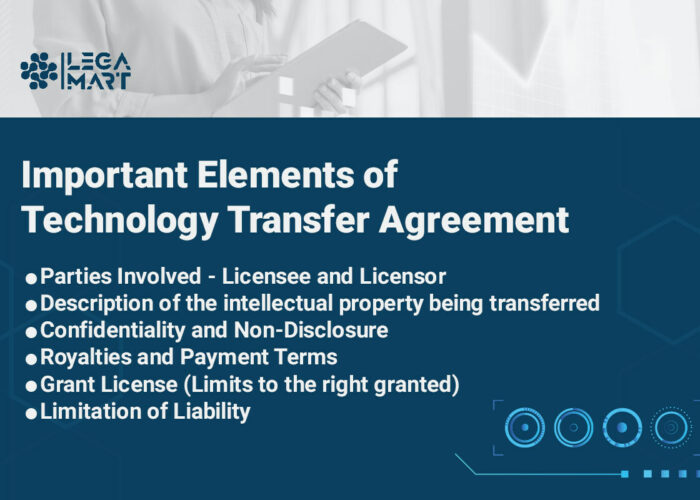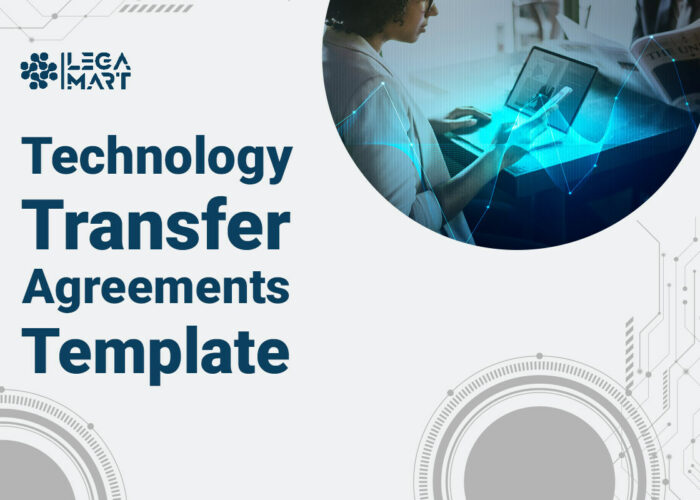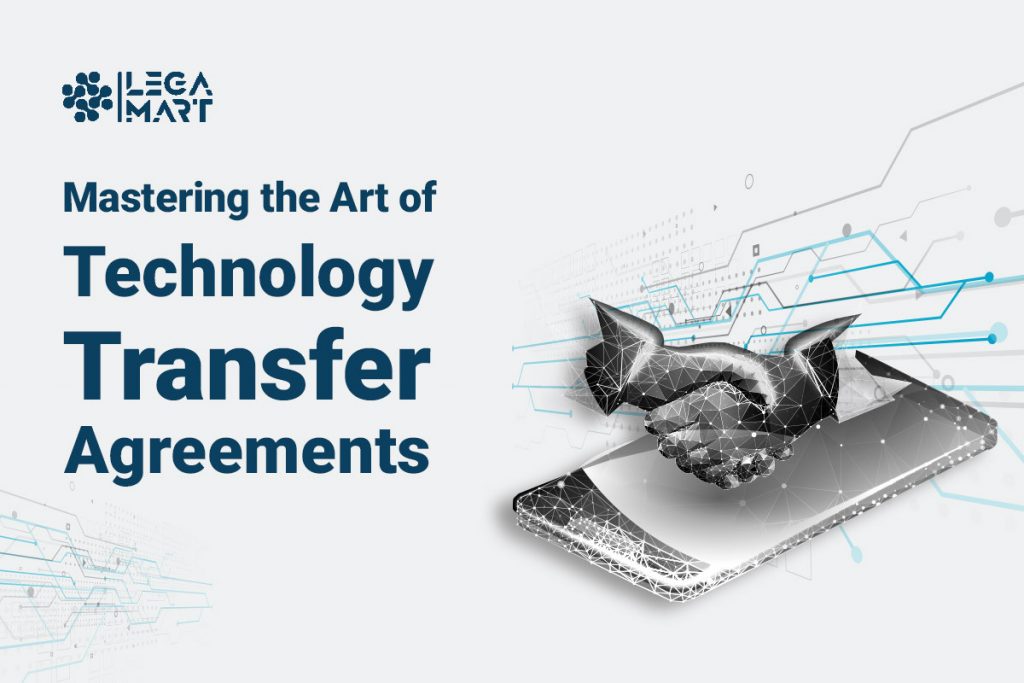Introduction
Consider a situation when a company decides to license its intellectual property to some other company or within a different management level within its own company to generate profits. What would be the best scenario to undertake this transfer? A Technology Transfer Agreement seems to be a good fit considering that the agreement helps in addressing potential difficulties and failures that may arise through systematic guidance on the decision-making procedure.
However, what is a technology transfer agreement, and how can it be helpful for your business? This article provides the necessary guidance for drafting a technology transfer agreement. So, let’s start!
Before we jump into that, if you want a well-drafted technology transfer agreement, Legamart is the place to go. With perfect legal guidance and resources, and personalised agreement formation, we are dedicated to providing quality services.
What is Technology Transfer?
Technology Transfer is the transfer of the latest technology from one company to another or within different levels of the same company. Through this procedure, commercial technology is disseminated, and technology transfer agreements act as a medium.
What is Technology Transfer Agreement?
The Technology Transfer Agreement (TTA) helps in the development of a legal relationship between a licensor (the transferring company) and the licensee (the receiving company). The licensor assigns or licenses their registered industrial or intellectual property rights (including patents, trademarks, copyrights, utility models, technical assistance, know-how, etc.) to the other company while allowing the licensor to retain ownership over their intellectual property.
Scope and Purpose of Technology Transfer Agreement
The transfer of technology, a critical process often handled through specialized legal frameworks central to Legal Practice & Specialization, becomes an important part of the technological innovation process by promoting technological and scientific research, along with the associated skills and procedures, to a wider community. This agreement facilitates this exchange of technology or intellectual property through various methods such as assignment, licensing, joint ventures, collaborative research, and development projects.
TTA provides assistance for tackling the following:
- Promoting business relationship
- Establishing a contractual agreement binding on the parties involved.
- Dealing with intellectual property transfer
- Assessing technologies
- Providing flexibility of coverage over different types of intellectual property rights
- Addressing potential contractual problems
- Facilitating non-licensing technology transfers in relation to procedures, know-how, and trade secrets
Methods of Technology Transfer
There are mainly 2 methods of technology transfer:
Vertical Transfer
Vertical transfer of technology occurs when a transfer occurs between entities at different production or value chain stages. An example can be the transfer from the Research & Development department to the Production & Commercialization department.
The transfer usually occurs from a more advanced entity to a less advanced one, such as from the technology owner or innovator to the licensee. Some common examples of vertical transfer are:
- Transfer of technology from a research institute to a private company for commercialisation.
- Transfer of technology from a multinational corporation to a local firm.
- Transfer of technology from a parent company to its subsidiary.
Horizontal Transfer
Horizontal transfer of technology occurs when a transfer occurs between entities operating at the same or similar production or value chain levels. This can be the technology transfer between competitors within the same sector or industry. Some common examples of horizontal transfer are:
- Sharing best practices between competing firms in the same industry.
- Research and development collaboration between companies operating in the same field.
- Acquiring intellectual property or technology from a competitor to enhance product offerings.
Important Elements of Technology Transfer Agreement
There are several important elements of a technology transfer agreement. While the specific terms and conditions can vary depending on the context and the parties involved, however, some common elements are the following:
Parties Involved – Licensee and Licensor
This acts as the opening clause of the technology transfer agreement and includes details about the parties that have entered into this agreement. The licensor is the person transferring the technology, while the licensee is the person accepting the transferred technology. The clause includes details related to the officially designated names, registered addresses, laws under which the company has been incorporated, authority for entering into the agreement, relevant contact information, etc.
Description of the intellectual property being transferred
The description clause is also known as the clause which provides the purpose of the technology transfer agreement, explaining why the agreement is being entered into. Therefore, within this clause, the parties are expected to provide a clear and detailed description of the intellectual property or technology being transferred, including the relevant details of the patents, copyrights, trademarks, trade secrets, know-how, software, etc. The parties must ensure they have a common understanding of the technology to avoid future conflicts.
Confidentiality and Non-Disclosure
This clause includes details about the confidential information the licensor shares with the licensee. Considering that the technology and intellectual property include important information related to the manufacture, use, and development of the technology, it becomes essential for the licensor to incorporate a strong confidentiality or non-disclosure clause to prevent any infringement of sensitive information.
Royalties and Payment Terms
This clause includes details about the mode of royalty payment, along with the percentage of the net sales or exports that shall be received as royalty by the licensor from the licensee. Other important information to be included is – payment structures (upfront fee, milestone payment, revenue-sharing arrangement), additional costs or expenses related to technology transfer (maintenance fee, support services), etc.
Grant License (Limits to the right granted)
This acts as the most critical part of the technology transfer agreement, considering that through this clause, the licensee obtains permission to use the technology. Therefore, it is important to draft this clause unambiguously, leaving no room for doubts or questions concerning the rights granted.
Limitation of Liability
This clause becomes important to define the limitations of the agreement and to address situations that can make the licensee liable. This clause addresses those situations or actions for which the parties cannot be held liable to pay damages, which helps limit the potential financial liabilities of the parties in case of breaches. It is important to consider the particularities of the technology and the jurisdiction of the technology transfer, considering the existence of specific enforceability limitations within certain jurisdictions.
Importance of Technology Transfer Agreement

A Technology Transfer Agreement is a crucial driver of innovation, collaboration, and economic growth in today’s business landscape. It facilitates the exchange of knowledge and advancements between universities, companies, regional and national economies, and society hence benefiting both parties. By facilitating the transfer and licensing of various intellectual property rights, technology transfer empowers organisations to collaborate, innovate, and commercialise ideas, driving economic prosperity and resource exchange. Ultimately, a well-structured Technology Transfer Agreement is essential for various reasons, including; –
Promoting Business Relationship
Universities greatly benefit from technology transfer initiatives as it enhances their research capabilities and boosts the reputation of the institution, its scientists, and their innovations. This, in turn, attracts top faculty talent and increases the likelihood of securing valuable grant funding.
Companies stand to gain significant advantages from technology transfer as well. They gain access to cutting-edge advancements developed within leading research institutes, leveraging the investments and expertise of world-leading scientists and engineers. By tapping into these technological breakthroughs, companies can enhance their product offerings, improve operational efficiencies, and gain a competitive edge in the market.
Addressing trans-national issues
Technology transfer plays a crucial role in developing many developing countries, primarily because most rely on foreign countries for new product knowledge. Due to limited resources, these nations often need to acquire technology from international markets. Without adequate technological development, a nation may lag and miss out on economic growth and competitiveness opportunities. Therefore, technology transfer becomes a means for developing countries to bridge this gap and catch up with more technologically advanced nations.
On the other hand, foreign firms prefer establishing research and development (R&D) centres in nations with stronger IPR protection while opting for sales and distribution centres in countries with weaker IPR protection. The advantage of technology transfer is that it can be leveraged across different geographic locations. In addition, stronger IPR protection reduces the risk of technology leakage and encourages technology licensing and joint ventures, while weaker IPR protection may discourage issues such as FDI and negatively impact the investment climate in a country.
Providing the flexibility of coverage of different types of IP
Technology transfer is crucial in providing the flexibility to cover different types of intellectual property (IP), particularly by enabling organisations to leverage various IP rights, such as patents, trademarks, copyrights, trade secrets, and know-how, for commercial and competitive advantage. Therefore, by facilitating the transfer and licensing of different types of IP rights, technology transfer broadens the possibilities for collaboration, innovation, and commercialisation, driving economic growth and fostering the exchange of ideas and resources between parties.
Technology Transfer Agreement Template

TECHNOLOGY TRANSFER AGREEMENT
This Technology Transfer Agreement (“Agreement”) is entered into between [Company A], a company incorporated under the laws of [Jurisdiction], having its principal place of business at [Address] (“herein transferor”), and [Company B], a company incorporated under the laws of [Jurisdiction], having its principal place of business at [Address] (“herein transferee”).
WHEREAS, [Company A] (“transferor”) possesses certain intellectual property, technical information, know-how, patents, trademarks, copyrights, trade secrets, and other proprietary rights (collectively referred to as the “Technology”) related to [describe the nature of the technology]; and
WHEREAS, [Company B] (“transferee”) desires to obtain a license to use the technology for the purposes of [describe the intended use of the technology];
NOW, THEREFORE, the Transferor and Transferee, hereinafter collectively referred to as the “Parties” and individually as a “Party,” having engaged in mutual negotiations and recognising the principle of equality and mutual benefit, hereby enter into this agreement and agree as follows:
Definitions
Unless otherwise stipulated, the terms and expressions used in this agreement shall have the same meanings as defined hereunder;
“Know-How” refers to the technical information, expertise, trade secrets, processes, methodologies, formulations, designs, specifications, and any other confidential or proprietary knowledge, as possessed by the transferor and to be transferred to the transferee under this agreement.
“Technology” refers to intellectual property, technical information, know-how, patents, trademarks, copyrights, trade secrets, and any other proprietary rights related to the technology being transferred.
“Transfer” refers to the process of conveying, assigning, or licensing the technology from the transferor to the transferee.
Technology Transfer Process
The transferor hereby agrees to transfer to the transferee the property rights in the know-how. The transferee shall have the exclusive right to use the know-how, including the ability to grant licenses to any third party for its use. This right extends to the exclusive manufacturing and sale of the technology based on the know-how. Furthermore, the transferee shall have the right to file for a patent application covering the know-how, protecting its intellectual property rights.
The transferor will provide the transferee with all necessary documentation, specifications, instructions, and other relevant information related to the technology.
Royalties and Payment Terms
The transferee shall pay royalties to the transferor for the use of the transferred technology as specified in this agreement. The royalties shall be calculated based on a percentage of the net sales or any other agreed-upon method. Parties agree that the royalty rate shall be [agreed percentage] of the net sales generated from commercialising products incorporating the transferred technology.
The transferee shall make royalty payments to the transferor on a [monthly/quarterly/annual] basis within [number of days] from the end of each [month/quarter/year]. All royalty payments shall be made in [currency].
Technical Instructions, Modification and Improvement
The transferor agrees to provide the transferee with necessary technical instructions related to the know-how, which will assist the transferee in utilising the know-how in question.
The transferor is also obligated to make necessary modifications and improvements to the technology.
Term and Termination
This technology transfer agreement shall commence on the effective date and shall continue until terminated by either Party in accordance with the termination provisions outlined herein.
Either Party may terminate this agreement upon a material breach by the other Party, provided that a written notice of such breach is provided and the breaching Party fails to remedy the breach within 30 days.
Governing Law and Dispute Resolution
This agreement shall be governed by and construed in accordance with the laws of [Jurisdiction].
In the event of a dispute arising in connection with the performance of this agreement, the Parties shall make reasonable efforts to resolve the dispute through amicable discussions and negotiations. If no mutually acceptable resolution can be reached, either Party may submit the dispute to arbitration.
The arbitration proceedings shall be conducted in accordance with the applicable arbitration rules of a mutually agreed-upon arbitration institution.
Representations and Warranties
The transferor possesses exclusive property rights in the know-how, and the use of the know-how by the transferee will not infringe upon any third party’s rights and interests. There are no current litigations or disputes relating to or arising from the know-how.
The transferor and transferee have diligently taken all necessary actions and obtained all required consents and approvals to authorise their entry into and execution of this agreement. The signing, execution, and performance of this agreement by both Parties will not violate any provisions of applicable laws or contractual obligations of mandatory enforcement.
Entire Agreement
This technology transfer agreement constitutes the entire understanding and agreement between the Parties regarding the Technology Transfer and supersedes any prior agreements or understandings, whether oral or written. Any amendments or modifications to this agreement must be made in writing and signed by both Parties.
Please indicate your acceptance of this agreement by signing below. This agreement shall become effective as of the date first written above.
[Transferor]
_____________
By: [Signature]
[transferee]
_____________
By: [Signature]
Conclusion
Technology transfer plays a vital role in promoting business relationships and fostering innovation. Thus, mastering the art of technology transfer agreements is crucial for businesses seeking to effectively manage and leverage their intellectual property assets. Technology transfer agreements provide a framework for the smooth technology exchange between parties, ensuring clarity regarding rights, responsibilities, and confidentiality. Particularly, these agreements facilitate the transfer of valuable technology, knowledge, and expertise between parties, enabling innovation, growth, and market expansion. Therefore, by mutually benefiting from technology transfer, companies can strengthen their collaborative partnerships, drive economic growth, and contribute to technological advancements in various industries.
Frequently Asked Questions
What is Technology Transfer Fee?
A technology transfer fee is a monetary payment or consideration made by the transferee (recipient of technology) to the transferor (owner of the technology) as compensation for the transfer of intellectual property rights, know-how, or technical expertise involved in the technology transfer agreement.
LegaMart is a global legal platform designed to connect individuals, startups, and businesses with qualified lawyers across jurisdictions. With a mission to simplify cross-border legal services, LegaMart provides users with access to a diverse network of vetted legal professionals who specialize in areas such as international law, corporate law, immigration, dispute resolution, and more.
By leveraging technology and user-friendly tools, LegaMart allows clients to search for lawyers by country, language, or legal expertise, submit their legal queries, and receive tailored legal solutions in a streamlined, efficient manner. The platform serves as a bridge between legal professionals and clients who need multilingual, multi-jurisdictional support — especially in today’s increasingly globalized legal landscape.
Whether you’re an entrepreneur launching a business abroad, an individual dealing with immigration paperwork, or a company navigating cross-border compliance, LegaMart aims to make legal help more accessible, transparent, and collaborative.




